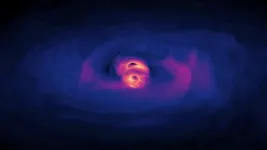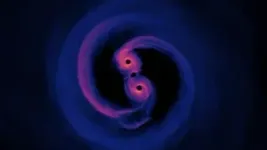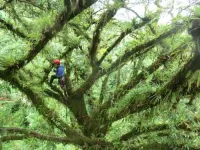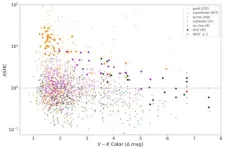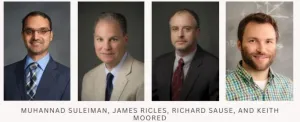(Press-News.org) Researchers have found a link between some of the largest and smallest objects in the cosmos: supermassive black holes and dark matter particles.
Their new calculations reveal that pairs of supermassive black holes (SMBHs) can merge into a single larger black hole because of previously overlooked behaviour of dark matter particles, proposing a solution to the longstanding “final parsec problem” in astronomy.
The research is described in Self-interacting dark matter solves the final parsec problem of supermassive black hole mergers published this month in the journal Physical Review Letters.
In 2023, astrophysicists announced the detection of a “hum” of gravitational waves permeating the universe. They hypothesized that this background signal emanated from millions of merging pairs of SMBHs each billions of times more massive than our Sun.
However, theoretical simulations showed that as pairs of these mammoth celestial objects spiral closer together, their approach stalls when they are roughly a parsec apart — a distance of about three light years — thereby preventing a merger.
Not only did this “final parsec problem” conflict with the theory that merging SMBHs were the source of the gravitational wave background, it was also at odds with the theory that SMBHs grow from the merger of less massive black holes.
“We show that including the previously overlooked effect of dark matter can help supermassive black holes overcome this final parsec of separation and coalesce,” says paper co-author Gonzalo Alonso-Álvarez, a postdoctoral fellow in the Department of Physics at the University of Toronto and the Department of Physics and Trottier Space Institute at McGill University. “Our calculations explain how that can occur, in contrast to what was previously thought.”
The paper’s co-authors include Professor James Cline from McGill University and the CERN Theoretical Physics Department in Switzerland and Caitlyn Dewar, a master of science student in physics at McGill.
SMBHs are thought to lie in the centres of most galaxies and when two galaxies collide, the SMBHs fall into orbit around each other. As they revolve around each other, the gravitational pull of nearby stars tugs at them and slows them down. As a result, the SMBHs spiral inward toward a merger.
Previous merger models showed that when the SMBHs approached to within roughly a parsec, they begin to interact with the dark matter cloud or halo in which they are embedded. They indicated that the gravity of the spiraling SMBHs throws dark matter particles clear of the system and the resulting sparsity of dark matter means that energy is not drawn from the pair and their mutual orbits no longer shrink.
While those models dismissed the impact of dark matter on the SMBH’s orbits, the new model from Alonso-Álvarez and his colleagues reveals that dark matter particles interact with each other in such a way that they are not dispersed. The density of the dark matter halo remains high enough that interactions between the particles and the SMBHs continue to degrade the SMBH’s orbits, clearing a path to a merger.
“The possibility that dark matter particles interact with each other is an assumption that we made, an extra ingredient that not all dark matter models contain,” says Alonso-Álvarez. “Our argument is that only models with that ingredient can solve the final parsec problem.”
The background hum generated by these colossal cosmic collisions is made up of gravitational waves of much longer wavelength than those first detected in 2015 by astrophysicists operating the Laser Interferometer Gravitational-Wave Observatory (LIGO). Those gravitational waves were generated by the merger of two black holes, both some 30 times the mass of the Sun.
The background hum has been detected in recent years by scientists operating the Pulsar Timing Array. The array reveals gravitational waves by measuring minute variations in signals from pulsars, rapidly rotating neutron stars that emit strong radio pulses.
"A prediction of our proposal is that the spectrum of gravitational waves observed by pulsar timing arrays should be softened at low frequencies," says Cline. "The current data already hint at this behavior, and new data may be able to confirm it in the next few years."
In addition to providing insight into SBMH mergers and the gravitational wave background signal, the new result also provides a window into the nature of dark matter.
“Our work is a new way to help us understand the particle nature of dark matter,” says Alonso-Álvarez. “We found that the evolution of black hole orbits is very sensitive to the microphysics of dark matter and that means we can use observations of supermassive black hole mergers to better understand these particles.”
For example, the researchers found that the interactions between dark matter particles they modeled also explains the shapes of galactic dark matter halos.
“We found that the final parsec problem can only be solved if dark matter particles interact at a rate that can alter the distribution of dark matter on galactic scales,” says Alonso-Álvarez. “This was unexpected since the physical scales at which the processes occur are three or more orders of magnitude apart. That’s exciting.”
-30-
END
A migraine is not just a bad headache. It is a much-dreaded part of a neurologic disorder that has an array of possible symptoms, including pulsating cranial pain, waves of queasiness, bouts of vomiting, and hypersensitivity to light and sound. They frequently materialize unannounced and at the most inopportune of moments.
Pubescent girls with a family history of migraine headaches are especially vulnerable — yet there remain many unknowns regarding the who, when and why of the disorder. Hadas Nahman-Averbuch, PhD, a scientist at Washington University School of Medicine in St. Louis with expertise ...
(Santa Barbara, Calif.) — The field of science aims to be objective, repeatable and justified in its choices and methods. These principles are what distinguish accepted scientific findings from pseudo-science. Yet the experience of learning and working in the field of science, including graduate school activities and scientific conferences, might not always follow the same principles. These practices and gatherings of scientists may be just as organic and random as evolution.
Have the traditions of science — rituals of poster presentations and tenure positions — evolved by chance? ...
PROVIDENCE, R.I. [Brown University] — Brown University biologists who set out to better understand the effects of climate change on plant species in tropical mountain regions found that even small variations in temperature and moisture can have massive impacts, threatening not only plants that live there, but also the ecosystems they support.
Emily Hollenbeck, who conducted the research while earning her Ph.D. in ecology and evolutionary biology from Brown, made the discoveries through a series of laborious yet informative experiments conducted in the Monteverde mountain ...
COLORADO SPRINGS, Colo. — Changing standard procedures for evaluating and treating patients with suspected stroke has led to improved access to lifesaving stroke surgery across the state of Delaware and should inform triage and treatment nationwide, according to research released today at the Society of NeuroInterventional Surgery’s (SNIS) 21st Annual Meeting.
In “Direct From the Field Bypass to CSC Improves Timeliness and Likelihood of Thrombectomy for Patients with Emergent Large Vessel Occlusion,” the members of the Delaware Stroke System worked with the state’s emergency medical services (EMS) director ...
EMBARGOED: NOT FOR RELEASE UNTIL 8PM UK TIME (3PM EASTERN TIME) ON 22 JULY 2024
Development of ‘living robots’ needs regulation and public debate
Bio-hybrid robotics creates unique ethical challenges, say researchers
Researchers are calling for regulation to guide the responsible and ethical development of bio-hybrid robotics – a ground-breaking science which fuses artificial components with living tissue and cells.
In a paper published in Proceedings of the National Academy of Sciences a multidisciplinary ...
Research led by Curtin University reveals that Earth’s largest iron ore deposits – in the Hamersley Province of Western Australia – are about one billion years younger than previously believed, a discovery which could greatly boost the search for more of the resource.
Using a new geochronology technique to accurately measure the age of iron oxide minerals, researchers found the Hamersley deposits formed between 1.4 and 1.1 billion years ago, rather than 2.2 billion years ago as previously estimated.
Lead author Dr Liam Courtney-Davies, who was a Postdoctoral Research Associate at Curtin University’s John de Laeter ...
How did the 2021 national marriage equality referendum campaign in Switzerland affect the well-being of the LGBTIQ+ community? A team led by researchers at UZH has shown that LGBTIQ+ individuals and their cisgender heterosexual allies exhibited more stress hormones during the controversial campaign.
Lesbian, gay, bisexual, trans, intersex and queer (LGBTIQ+) individuals face persistent structural inequalities and discrimination that can adversely affect their well-being. When concerns of the LGBTIQ+ community are discussed in widespread public debates, such as during political initiative and referendum campaigns, that can ...
Interest in Earth-like planets orbiting within the habitable zone of their host stars has surged, driven by the quest to discover life beyond our solar system. But the habitability of such planets, known as exoplanets, is influenced by more than just their distance from the star.
A new study by Rice University’s David Alexander and Anthony Atkinson extends the definition of a habitable zone for planets to include their star’s magnetic field. This factor, well studied in our solar system, can have significant implications for life on other planets, according ...
In the past few years, we’ve seen a push toward renewable energy. One focus is wind, which is harvested via turbines–you may have seen them in mountainous areas, turning in the wind. But the United States’s most abundant wind potential lies offshore; wind speeds are highest off both coasts. This means offshore wind turbines promise high energy yields, akin to the offshore wind production in the North Sea near northern Europe.
But constructing wind turbine platforms in water deeper than ~60 meters presents problems. Turbines in shallow waters, like those in the North Sea, can be mounted on fixed-bottom platforms, held ...
COLORADO SPRINGS, Colo. — There is a potential connection between a diagnosis of certain gastrointestinal (GI) syndromes and the formation and rupture of intracranial (brain) aneurysms, according to research presented today at the Society of NeuroInterventional Surgery’s (SNIS) 21st Annual Meeting.
An intracranial aneurysm (IA) occurs when a blood vessel in the brain bulges, putting pressure on the vessel wall. IAs that rupture cause brain bleeding and lead to a hemorrhagic stroke, a life-threatening emergency requiring immediate medical attention ...
